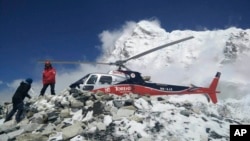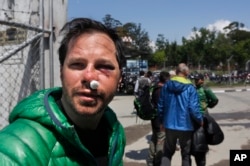Efforts continued Monday to rescue climbers stranded on the world’s highest peak, Mount Everest, where avalanches triggered by Saturday’s earthquake have killed at least 18 people.
Helicopters began ferrying out some of the more than 100 mountaineers trapped above base camp on the mountain, which straddles the border between Nepal and China and lies about 240 kilometers or 150 miles due east of the quake’s epicenter.
The death toll for the 7.8-magnitude quake already has surpassed 3,700 in the region. Continuing aftershocks threaten to unleash more avalanches at the outset of the climbing season.
Hundreds of mountaineers were on Everest – a peak of 8,850 meters or 29,035 feet – when the quake struck. Onslaughts of snow and debris hit Everett Base Camp, at 5,545 meters or 18,192 feet, where the 18 were killed and dozens more were injured. Three of the dead were American climbers.
"The snow swept away many tents and people," sunburned guide Gyelu Sherpa told the Associated Press. He was among the first 15 injured survivors to be transported to the capital, Kathmandu, for treatment.
A Sherpa cook, Bhim Bahadur Khadtri, 35, said he was preparing a meal when the avalanche rumbled. "We all rushed out to the open and the next moment a huge wall of snow just piled on me," he told the AP in brief airport interview before he was driven to a hospital. "I managed to dig out of what could easily have been my grave. I wiggled and used my hands as claws to dig as much as I could. I was suffocating, I could not breathe. But I knew I had to survive."
Key equipment swept away
The snow’s force wiped out climbing ropes and other equipment used in ascents, stranding climbers at several higher camps.
Ed Viesturs, a celebrated U.S. climber who has reached Everest’s peak seven times in 11 attempts, described to VOA the challenges facing mountaineers and rescuers.
"The people at Camp 1," the lowest of four camps above the base, "are at about 20,000 feet," Viesturs told VOA by phone from Ketchum, Idaho. "If they’ve got feed and fuel – fuel to melt snow to make water – they can survive there for a good period of time."
Experienced guides scale the mountain gradually, spending roughly a week at base camp, to acclimate to oxygen levels that decrease at higher altitudes.
But Viesturs said the thinning air creates difficulties for helicopters. "The air is so thin, the amount of lift they have is minimal, so you can’t add a lot of extra weight," he explained. The choppers likely could carry "one or two, maybe three people at a time, so there’s going to be a lot of shuttling."
Landing spots also are difficult to find on the mountain, Nepal’s tourism minister, Tulsi Gautam, told the BBC.
Some walked to safety or treatment
The mountaineers, including some injured, walked down from base camp to seek treatment or shelter.
Viesturs said he was relieved to learn his friend, filmmaker David Breshears, had gotten to safety after the avalanche. Breshears had co-directed "Everest," an IMAX film whose production was disrupted by a 1996 blizzard that killed eight climbers.
Monday’s weather on Everest was "good," enabling evacuations to continue at Camps 1 and 2, rescued U.S. climber Jim Davidson said in a Facebook update. "I am safe in basecamp now … the injuries, fatalities & tragedy are heartbreaking."
Another documentary filmmaker, Michael Churton, was at Everest’s base camp when the snow and ice thundered in.
"It's a big ice shelf and it must have just released," the 38-year-old New Yorker told the AP Monday in Kathmandu. He was with four colleagues at the time.
"We saw it hit, it kind of hits one level and then it just shot right back up.… It was like 4,000 feet of snow just kind of coming and there's nowhere to run," Churton said. "So I told everybody to get down and then put my hands over my head and, like, just buried myself as much as I could. And basically snow hit, it's about 45 seconds or a minute for it to go by.''
Concern for locals
Climber Nick Ciensky had helped recover the bodies of at least 12 avalanche victims. "We are still sorting through a lot of emotions; 24 hours ago, we were wrapping people’s body parts in bags," the Canadian told Reuters news agency.
Like Viesturs, he expressed grave concern for the Sherpas and other Himalayans. The deadly avalanche comes roughly a year after the April 18 avalanche that killed at least 13 Sherpas on Everest, inciting anger among the local populace over their low pay and high risk.
This year’s tragedy makes a dismal start to the climbing season, which brings vital money into Nepal’s economy. Mountaineers pay a standard fee of $65,000 to climb with Russell Brice’s Himalayan Experience, Reuters noted.
"Climbing mountains is inherently risky and dangerous," Viesturs observed. "… The way we minimize the risk is by being smart and conservative and humble.
"But this was an event that was completely unpredictable," he said. "It caught people at a base camp considered a haven of safety. And now it’s not."











